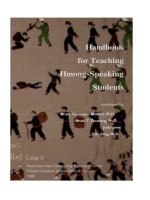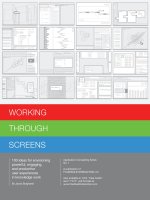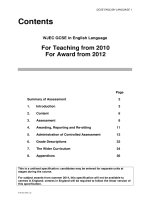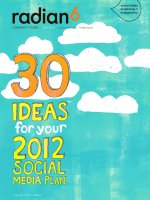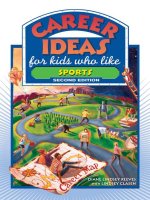100 Ideas for Teaching Geograp - Andy Leeder
Bạn đang xem bản rút gọn của tài liệu. Xem và tải ngay bản đầy đủ của tài liệu tại đây (2.77 MB, 141 trang )
100 IDEAS
FOR TEACHING GEOGRAPHY
CONTINUUM ONE HUNDREDS SERIES
100 Ideas for Assemblies: Primary Edition - Fred Sedgwick
100 Ideas for Essential Teaching Skills - Neal Watkin and
Johannes Ahrenfelt
100 Ideas for Managing Behaviour - Johnnie Young
100 Ideas for Supply Teachers: Primary Edition - Michael Parry
100 Ideas for Supply Teachers: Secondary Edition - Julia Murphy
100 Ideas for SurvivingYour First Year in Teaching - Laura-Jane Fisher
100 Ideas for Teaching Creativity - Stephen Bowkett
100 Ideas for Teaching Citizenship - Ian Davies
100 Ideas for Teaching English - Angella Cooze
100 Ideas for Teaching Geography - Andy Leeder
100 Ideas for Teaching History - Julia Murphy
100 Ideas for Teaching Languages - Nia Griffith
100 Ideas for Teaching Mathematics - Mike Ollerton
100 Ideas for Teaching Science - Sharon Archer
100 Ideas for Teaching Thinking Skills - Stephen Bowkett
100 Ideas for Trainee Teachers - Angella Cooze
100 IDEAS
FOR TEACHING
GEOGRAPHY
Andy Leeder
continuum
LONDON
•
NEW YORK
Continuum International Publishing Group
The Tower Building
11 York Road
London
SE1 7NX
80 Maiden Lane
Suite 704
New York
NY 10038
www. continuumbooks. com
© Andy Leeder 2006
All rights reserved. No part of this publication may be reproduced
or transmitted in any form or by any means, electronic or
mechanical, including photocopying, recording, or any information
storage or retrieval system, without prior permission in writing
from the publishers.
Andy Leeder has asserted his right under the Copyright, Designs
and Patents Act, 1988, to be identified as Author of this work.
British Library Cataloguing-in-Publication Data
A catalogue record for this book is available from the
British Library.
ISBN: 0-8264-8538-3 (paperback)
Library of Congress Cataloging-in-Publication Data
A catalog record for this book is available from the Library of
Congress.
Typeset by Ben Cracknell Studios
Printed and bound in Great Britain by MPG Books Ltd,
Bodmin, Cornwall
CONTENTS
INTRODUCTION: GETTING THE MOST FROM THIS BOOK XI
SECTION I
Maintaining a high profile for the subject
1
KEEPING SENIOR MANAGERS UP TO DATE
2
2
KEEPING PARENTS UP TO DATE
3
3
OPEN EVENINGS
4
4
GEOGRAPHY IN THE NEWS: HIGH-PROFILE DISPLAYS
5
5
ASSEMBLIES 1: FINITE RESOURCES
6
6
ASSEMBLIES 2: LOTS OF OPINIONS, DIFFICULT DECISIONS
7
7
GEOGRAPHY PATHWAYS: KNOWLEDGE AND INFORMATION 8
8
GEOGRAPHY: WHY IS IT UNIQUE?
SECTION 2
9
10
9
Lesson activities: starters
GET YOUR STUDENTS WARMED UP!
12
A CRISP START TO THE LESSON
13
11
12
AMAZING FACTS
14
SLIDE SHOW: A SENSE OF PLACE
15
13
14
15
WHERE IN THE WORLD?
16
JIGSAWS
17
CARTOONS
18
16
DINGBATS
19
SECTION 3
Lesson activities
17
GENERAL CONSIDERATIONS
22
18
INNOVATION AND THINKING SKILLS
23
19
HELPING STUDENTS GAIN A SENSE OF PLACE
24
20
21
WRITING FRAMES (SCAFFOLDS)
25
LISTENING FRAMES
26
22
SEQUENCING
27
23
24
25
SEQUENCING WITH CLIMATE GRAPHS
28
USING MIND MAPS
29
LETTER WRITING
31
26_
WRITTEN REPORTS IN A NEWSPAPER FORMAT
32
27
28
29
MATCHING WORDS AND PHRASES TO DEFINITIONS
33
USING CARTOONS
34
TALKING HEADS
35
30
I AGREE/I DISAGREE
36
31
32
I AGREE/I DISAGREE: MAKING IT WORK WITH SEN STUDENTS 37
JUSTIFYING OPINIONS
38
33
USING ORDNANCE SURVEY MAPS: A VALUABLE TOOL
39
34
USING ORDNANCE SURVEY MAPS: DEVELOPING SKILLS
40
35
USING ORDNANCE SURVEY MAPS: LEARNING IS FUN
41
36
USING MUSIC/FILMS/TV TO ENHANCE LESSONS
42
SECTION 4
The classroom environment
37
THE WELL-EQUIPPED GEOGRAPHY ROOM
46
38
ROOM LAYOUT
47
39
PUTTING STUDENTS' WORK ON DISPLAY
48
40
DISPLAYING DEFINITIONS OF KEY GEOGRAPHICAL WORDS 49
41
42
DISPLAY USING WALL MAPS
50
A BANK OF OUTLINE MAPS
51
SECTION 5
Field trips
43
44
45
VITAL CONSIDERATIONS
54
HEALTH AND SAFETY: RISK ASSESSMENT
55
INFORMATION FOR PARENTS
56
46
TEAMWORK: STAFFING THE TRIP
57
47
48
GEOGRAPHY STAFF: SPOILT FOR CHOICE?
58
OVERSUBSCRIBED TRIPS: SELECTING STUDENTS
59
49
USING COMMERCIAL COMPANIES
60
50
USING EXPERTS/TOUR GUIDES
61
51
STUDENT RESOURCES
62
52
BALANCING WORK AND PLAY ON RESIDENTIAL TRIPS
63
SECTION 6
Links with other subjects
53
LINKS WITH ENGLISH
66
54
LINKS WITH MATHS
67
55
LINKS WITH SCIENCE
68
56
CITIZENSHIP: BE AWARE OF STATUTORY REQUIREMENTS
69
57
CITIZENSHIP: A GEOGRAPHICAL CONTEXT
70
58
LINKS WITH INFORMATION AND COMMUNICATIONS
TECHNOLOGY
SECTION 7
71
Useful contacts
59
PARENTS ARE A USEFUL RESOURCE
74
60
LOCAL RADIO
75
61
EXAM BOARDS 1: WHY BECOME AN
EXAMINER/MODERATOR?
76
62
EXAM BOARDS 2: OTHER BENEFITS - NETWORKING
77
63
EXAM BOARDS 3: MAKING CONTACT AND CURRICULUM
DEVELOPMENT
78
64
CHARITIES 1: A VALUABLE RESOURCE, A CHANCE TO MAKE
A DIFFERENCE
79
65
CHARITIES 2: CHRISTIAN AID
80
66
CHARITIES 3: CAFOD
81
67
THE METEOROLOGICAL OFFICE
82
SECTION 8
The sustainable geography department
68
EDUCATION FOR SUSTAINABLE DEVELOPMENT (ESD)
86
69
ESD: WRITING IT INTO SCHEMES OF WORK
87
70
ESD: MODELLING THE MESSAGE
88
SECTION 9
71
72
73
74
75
Homework and revision
GENERAL TIPS
92
HOMEWORK: USING COMMERCIAL MATERIALS
93
HOMEWORK: LETTING YOUR VALUABLE RESOURCES
GO HOME
94
REVISION 1: USING COMMERCIAL MATERIALS
95
REVISION 2: EXAM TECHNIQUE
96
SECTION 10 Information and communications
technology
76
77
78
79
80
81
82
83
84
85
86
87
88
89
90
91
A GENERAL TIP
100
A WIDE RANGE OF APPLICATIONS
101
A WORD OF CAUTION!
102
THE INTERNET: GATEWAY TO A WEALTH OF RESOURCES 103
THE NATIONAL CURRICULUM IN ACTION WEBSITE
104
THE NATIONAL GRID FOR LEARNING
105
THE ROYAL GEOGRAPHICAL SOCIETY (WITH IBG)
106
THE GEOGRAPHICAL ASSOCIATION'S WEBSITE
107
MORE EFFECTIVE SEARCHING ON THE INTERNET
109
MAKING USE OF YOUR SCHOOL'S INTRANET
110
USING INTERACTIVE WHITEBOARDS
111
GEOGRAPHICAL INFORMATION SYSTEMS
112
CD-ROMS AND GEOGRAPHY
113
DIGITAL CAMERAS
114
USING MICROSOFT POWERPOINT
115
ACCESSING CENSUS DATA: THE UK CENSUS
116
92
ACCESSING CENSUS DATA: POPULATION AND
ECONOMIC DATA
118
93
VIDEO/DVDS
119
S E C T I O N I I Other key ideas
94
95
96
97
FUN AT THE END OF TERM: TRADITIONAL GAMES
122
FUN AT THE END OF TERM: IT SUPPORT
123
KEEPING YOURSELF UP TO DATE
124
KEEPING RESOURCES UP TO DATE
125
98
TEACHING GIFTED AND TALENTED GEOGRAPHERS
126
99
100
LINKS WITH PRIMARY SCHOOLS
127
A PICTURE OF BRITAIN
128
This page intentionally left blank
INTRODUCTION
This book has been written with a view to helping
geographers new to the teaching profession and to
encourage experienced geographers to further develop
their teaching and learning strategies. The tips contained
in the book are tried and tested and are the result of over
twenty-five years of experience in the classroom. I am
indebted to my colleagues, who have been central to
developing many of the ideas; their inspiration and
commitment to helping students and to flying the flag for
geography have been great motivating factors in writing
this book. When you witness something that works well
and moves students on, it should be recognized.
Moreover, as the subject has developed at a rapid pace
over the years, not least in the resources available to
enhance learning in the subject, it is important to signal
the new opportunities that are at hand.
The main focus of the book is to promote the notion
that learning programmes can be varied, fun and
challenging. Given the competition that geography faces
in a crowded and developing curriculum, the book also
suggests strategies to help maintain its rightful position
as an essential subject for study beyond Key Stage 3. Dip
into the ideas and tips given here, and develop them to
suit your own needs and circumstances. Take risks in
your own teaching and always be prepared to learn from
others. Happy reading.
A special mention needs to be made of Graham
Heywood, Alan Moon, Gererd Dixie and Steve
Brenchley. All of them are exceptional teachers in their
own right and great ambassadors for the subject.
The cartoons used in the book were drawn by Roy
Fitzsimmonds.
XI
This page intentionally left blank
SECTION
1
Maintaining a high
profile for the
subject
IDEA
1
If the management team in your school is devoid of
geographers and if they retain some of their former
prejudices about the subject (it's all about colouring
maps and finding out about places like Ceylon - yes, I
know it's called Sri Lanka now!), you need to take
action. Particularly in the post- 'Opportunities and
Excellence' era, in which schools have a responsibility to
develop, widen and update their post-14 curriculum,
complacent geographers will lose out, and so will the
students. What can you do?
Make managers sit up and take notice by achieving
consistently good exam results. Residuals scores will
confirm that you can get the best out of the full ability
range. If you join a school where the starting point in
geography is problematic, work hard to get the
teaching and learning strategies right.
Think carefully about your strategy throughout Key
Stage 3 and in particular the experience that students
have just ahead of Year 9 options. If there is no
structured, whole-school approach to option choices,
ensure that time is given over in lessons to explain the
rich pathways for geographers beyond 16.
Remind managers constantly about their
responsibilities to ensure education for citizenship and
sustainable futures. Illustrate how geographers can
take the lead.
Remind them of the kudos with parents which stems
from successful school trips.
Overtly illustrate the way that geography contributes
to their literacy, numeracy and ICT strategy.
2
As with Idea 1, you need to keep parents informed about
the many valid reasons for studying geography beyond
14 and into post-16 education. If your teaching and
learning strategies are sound and secure, the students
should support you in your drive to keep geography
buoyant post-14. However, parents, like senior managers,
have their own prejudices about the subject.
IDEA
2
Use opportunities such as open evenings to present
the subject in a stimulating way (see Idea 3).
Whatever the format for Year 9 and Year 11
'choices/options' evenings, ensure that you have
well-presented flyers to illustrate career paths and
pathways.
Challenge the parents with information about how
their son or daughter is going to be knowledgeable
and ready to play a full part in our fast-changing
world.
Make them aware of the fact that geography has
moved on. Don't hold back from using and applying
information and communications technology (IGT) to
a range of geography contexts. Educate them that
geography is also about reasoned opinions, challenge,
and values and attitudes.
3
IDEA
3
Open evenings are a great opportunity to show
prospective students and their parents just what a
stimulating and challenging subject geography is.
Whether it is an open evening targeted at children
transferring from primary schools or perhaps an evening
set up to recruit prospective A-level students, it is worth
making the display and/or activities dynamic.
Display work produced by students at all different
levels. Ensure that the work on display is assessed. If a
grading or level system is used, ensure that both the
students and their parents understand the criteria for
assessment. Of equal importance, make sure that teacher
comments are formative and that appropriate praise is
given. Areas for further development should be
suggested, clearly indicating that the department has
challenge and development at the heart of its work.
Alongside students' work, display the rich array of
teaching resources used in the department. From
selected pages in textbooks to worksheets and
photographs, challenge the visitors by highlighting how
and why the material is used. To avoid the more sterile
displays seen at too many open evenings, try to introduce
some 'hands-on' activities:
accessing CD-ROMs or the school's intranet;
quizzes, or 'where in the world' picture challenges.
A dramatic impact can be made by constructing a
tropical rainforest room. Use loads of heaters and tea
urns to generate heat and humidity, borrow lots of
luxurious plants and set up a large screen showing video
clips of the fantastic ecosystem, combined with dramatic
images of damaging exploitation.
4
Geographical issues are rarely out of the news. When a
major event occurs, such as the Asian tsunami of
December 2004, or the flooding at Boscastle in August
2004, even the tabloid newspapers dedicate several
column inches to the event. Despite extensive parallel
coverage on television and radio, some students appear
to know very little about the event, apart from the
headline. A small minority remain blissfully ignorant
of it.
If you are lucky enough to have a central display area,
why not dedicate the space to the theme of * Geography
in the News'? A determined effort to keep the display up
to date will keep the students interested and expectant.
If the presentational style is carefully considered and
accessible to students, it will engage them and may
encourage them to find out more. It will give them
access to events or news items that may be of huge
significance, but may be reported only in some of the
more environmentally aware newspapers such as the
Guardian or the Independent.
Have a world map as the permanent backdrop to the
display to increase knowledge of location. Have a large
banner headline to draw them in. Display cuttings and
photographs from the original article but prepare a 'key
facts' summary. Prepare a few searching questions to
stimulate further thinking.
The good news is that the teaching staff do not have
to get involved in changing the display on a regular basis.
Once staff have invested the time to get the display
backdrop in place, subsequent work can be handed over
to a student who has been identified as having
exceptional gifts and talents (see Idea 98) or to a willing
A-level student. The end product is educative and
inclusive, and helps the geography department to cement
its profile within the school.
IDEA
4
5
IDEA
5
From time to time, geography teachers are asked to plan
and deliver the whole-school assembly. Look at this as an
opportunity rather than a chore. It's the perfect
opportunity to raise the profile of the subject. It could
also be a good opportunity to deliver one of the elements
of citizenship assigned to the geography team. This tip
suggests an assembly which can be delivered by one
member of the geography team; the next tip requires the
involvement of a small number of 'volunteer' students.
SPACESHIP EARTH: FINITE RESOURCES
This assembly will be significantly enhanced if the
delivery is supported by a few carefully selected images.
Ideally, they would be projected from a laptop, but
overhead transparencies would suffice. Launch the
assembly by talking about unnecessary waste around the
school (paper/electric lights/running taps, etc.). Move on
to the obvious financial implications of waste, but quickly
move on further to the wider issue of using up finite
resources. Students quickly grasp the message if you
portray the Earth as a spaceship. Within the spaceship an
array of cupboards contain a wealth of resources. After
continuous raiding, the cupboards will eventually be
bare. Pose the question, what can we all do to prevent us
getting to this point?
6
Another idea for an assembly is to alert students to the
fact that, in life, differences of opinion exist across a
multitude of issues. Moreover, when difficult decisions
need to be made, compromise may not be an option;
some people may be unhappy with the outcome.
Start by focusing minds on a school-based issue on
which differences of opinion exist. One example includes
the controversy of having an 'open school' policy
throughout lunchtime, as opposed to a 'lock out'.
Alternatively, there are often disputes simmering when
changes to the school uniform are being considered.
Whatever is chosen, selected students could voice a range
of strong opinions to the audience. The teacher in charge
of the assembly could reflect on each opinion and debate
the potential for compromise. He or she might point out
that compromise could be the worst of all options. An
extension to this theme would be to introduce the notion
of appeasement for those who ultimately feel let down.
Having focused minds, move swiftly on to parallel
geography debates. Repeat the mode of delivery using
the students.
IDEA
6
o Perhaps the issue is local: alternative routes for a
bypass?
o Perhaps it's national: airport expansion on the back of
ever-increasing numbers of budget airlines?
o Perhaps it's international: aid or trade for
development in Africa?
Differences of opinion? Hard decisions? Possibility of
compromise? Appeasement? All are features of a
geographical debate, ripe for assemblies.
7
IDEA
7
8
The world of work is constantly changing., and change
occurs at an ever-increasing rate. This idea urges all
geographers to maintain an interest in and a determined
effort to keep up to date with the pathways and careers
open to students who study geography. In a curriculum
that becomes ever more competitive, particularly in Key
Stages 4 and 5, we need to remind students and their
parents of the opportunities that lie beyond study in
school.
While we know that geography develops a wide range
of transferable skills attractive to employers, it is
necessary for students and parents to be informed of
this. Help is at hand: you do not have to reinvent the
wheel! The Royal Geographical Society (in association
with the Institute of British Geographers), can provide
you with a wealth of material for use in your school.
From free posters to a free Microsoft PowerPoint
presentation, a free video (why choose geography at
GCSE?) and interviews with well-known personalities,
they can supply you with all you need. Go to their
website at www.rgs.org and follow the links through
'education5 and then 'advice and careers' for all you
need.
As was stated in Idea 1, geography can be a key subject in
delivering essential skills and cross-curricular themes. There
are times, however, when students and parents ask us what
is unique about the subject that will provide students with
something that others cannot provide. Always have at your
fingertips a response. The list below may give you a starting
point. Geography allows students:
IDEA
8
to answer questions about the natural and human
worlds, using different scales of inquiry to view them
from different perspectives;
to develop awareness and understanding of a range of
peoples and cultures, and a respect for many different
attitudes, views and beliefs;
to gain experiences that help them make connections
between themselves, their communities and the wider
world;
to explore issues of environmental change and
sustainable development, and develop the skills and
attitudes necessary for active involvement as citizens;
to develop and extend their investigative and problemsolving skills, including skills in number and
information and communications technology (ICT),
inside and outside the classroom;
to recognize the need for a just and equitable society,
and their own role in making this possible.
9
This page intentionally left blank
SECTION
2
Lesson activities:
starters
IDEA
9
12
This idea will explain some of the reasons why
educationalists promote the idea of 'mental warm-ups5
and kinaesthetic activity, both of which can form the
basis of any starter activity.
There is a wide range of research to confirm that a
'warmed-up' brain makes for more effective learning.
Warm-ups, particularly the use of more ambitious warmup exercises that might require movement or sorting or
grouping, etc., may be of particular value to students
who have special needs. There is a wealth of information
on the advantages of using a wide variety of learning
styles, not least because we know that students learn
effectively in very different ways and in a multitude
of ways.
Geography provides a rich context for devising starter
activities. As the National Learning Strategy makes clear,
the teacher who recognizes the value of shaping the
learning programme around a combination of visual,
auditory, kinaesthetic and collaborative experiences is a
teacher who will access the full range of students'
learning strengths.
Access to learning through visual stimulus alone
illustrates the head start that geography teachers have,
compared to others. Without stopping to think why, we
enthusiastically embrace the use of photographs,
diagrams, sketches, film, video, cartoons, maps, etc. You
will see from the examples in Ideas 11-16 that visual
stimuli can form the basis for many starter activities.
They engage students and draw them into the rest of the
learning programme. More often than not, they are fun.
It may be that starter activities are the place where
geographers who up until now have relied on a very
conservative range for their learning programme decide
to experiment. The dividends will be for all to see and
enjoy.

